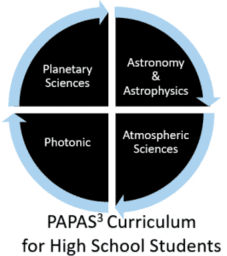Esquema
PAPAS^3 Curriculum in Space Science
The Planetary, Astronomy, Photonic, and Atmospheric Sciences in Space Science (PAPAS^3) Curriculum could be used in programs such as the Arecibo Observatory Space Academy, workshops, or any other program for High School Students.
It offers guidance for activity and lesson plan preparation in Space Science that meets the educational standards set by Department of Education of Puerto Rico.
It Includes Science, Technology, Research, Engineering, Arts and Mathematics (STREAM) and Project-Based Learning (PBL) concepts using Geogebra.
This research was supported by National Science Foundation.
I thank all my Arecibo Observatory mentors who provided insight and expertise that greatly assisted the research,
although they may not agree with all of the interpretations and conclusions of this presentation.
Mentor List: Anne Virkki, Sean Marshall and Flaviane Venditti (Planetary), Andrew Ortiz (Visitor Center), Andrés Díaz (Photonics), Kristen Jones and Nipuni Palliyaguru (Astronomy), and Eliana Nossa, Néstor Aponte, Pedrina Santos, Christiano Brum, and Jens Lautenbach (Atmospherics).
Planetary, Astronomy, Photonic Atmospheric Sciences Space Science, PAPAS^3, Curriculum Arecibo Observatory Space Academy, Space Science, Science, Technology, Research, Engineering, Arts, Mathematics, STREAM, Project-Based Learning, PBL, Geogebra

Tabla de contenidos
Planetary Science
Photonic
Astronomy
Atmospheric Science
Space Science Functions
- Peak Wavelength Radiation Function
- Witch of Agnesi Function Model
- Exponential Function Model
- Rational Gravitational Field Model
- Logarithmic Gravitational Field Model
- Gaussian Gravitational Field Model
- Lanzamiento de un Cohete Espacial - Función & Gráfica de Altura & Velocidad de un Cohete Espacial - Física - Cinemática
Astronomical Structures
Trigonometry
- Problema Verbal de Trigonometría con Tangente - Radio de un Satélite desde un Planeta
- Problema Verbal de Trigonometría - Comunicaciones, Satélite Artificial & Órbita Terrestre
- Problema Verbal de Trigonometria - Radio de Planeta - Distancia de Separación del Satélite Artificial - Ángulo de Visión - Ángulo de Apertura